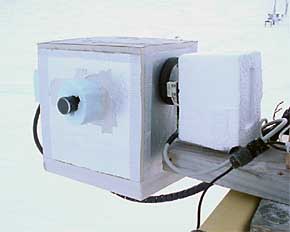Bad Gas Examined During Field Campaign at North Slope of Alaska
Published: 15 March 2005

Springtime in the Arctic produces reactive halogen gases, such as bromine monoxide, that form from evaporating sea salt. These gases destroy ground-level ozone and convert gaseous mercury into toxic snow-bound mercury ions that can end up in the ecosystem. To better understand this atmospheric chemistry and the subsequent impacts to environmental and human health, researchers funded by the National Science Foundation (NSF) are measuring the concentration of halogen gases during a three-month field campaign hosted at ARM Climate Research Facility’s Atqasuk site at the North Slope of Alaska (NSA). The focus of the field campaign, referred to as Studies of the Northern Alaskan Coastal System, is a remote-sensing technique that uses multiple axis differential optical absorption spectroscopy (MAX-DOAS). The MAX-DOAS instrument scans the sky from the zenith to the horizon, taking measurements of halogen oxide. Vertical profiles of this gas show its presence in both the stratosphere and in the planetary boundary layer (typically the lowest kilometer of the earth’s atmosphere). It is bromine monoxide in the boundary layer that is of interest to researchers in this field campaign.
The instrument was installed at Atqasuk on February 16, 2005. At the conclusion of the field campaign in May, data from the instrument will be correlated with meteorological information from the ARM Data Archive to investigate how air mass origin affects halogen oxides. The measurements will also be compared with those taken by a similar instrument located at NSF facilities in Barrow, Alaska, approximately 70 miles north of Atqasuk. Comparison of the measurements between the two sites will provide information on how the halogen oxides are formed and their concentration gradients at NSA. Through improved understanding of these halogen oxides, scientists can better predict how changes in pollutant emissions and global climate affect the deposition of toxins and their atmospheric oxidation.
The ARM Climate Research Facility is a DOE Office of Science user facility. The ARM Facility is operated by nine DOE national laboratories, including .
Keep up with the Atmospheric Observer
Updates on ARM news, events, and opportunities delivered to your inbox
ARM User Profile
ARM welcomes users from all institutions and nations. A free ARM user account is needed to access ARM data.


















